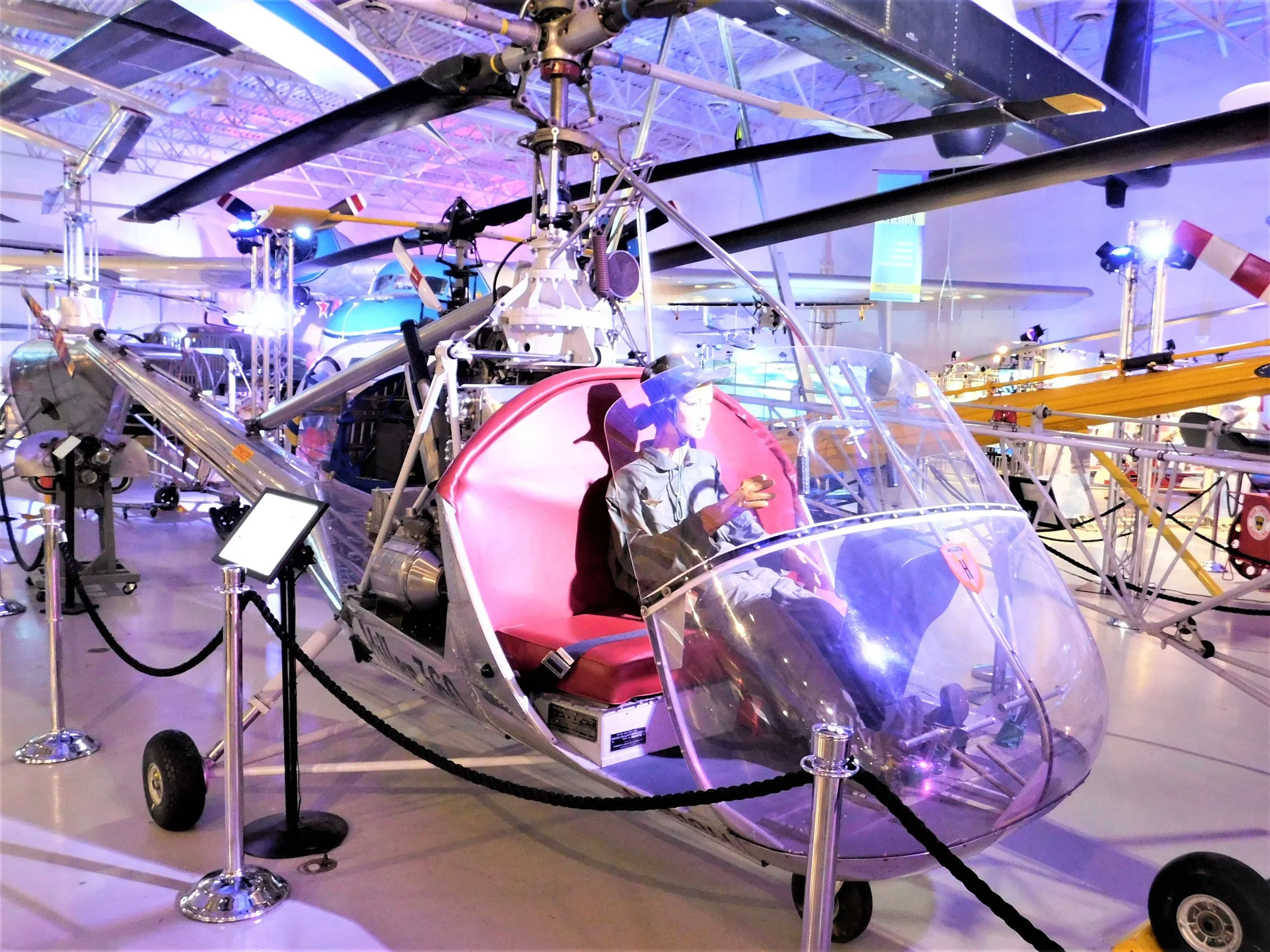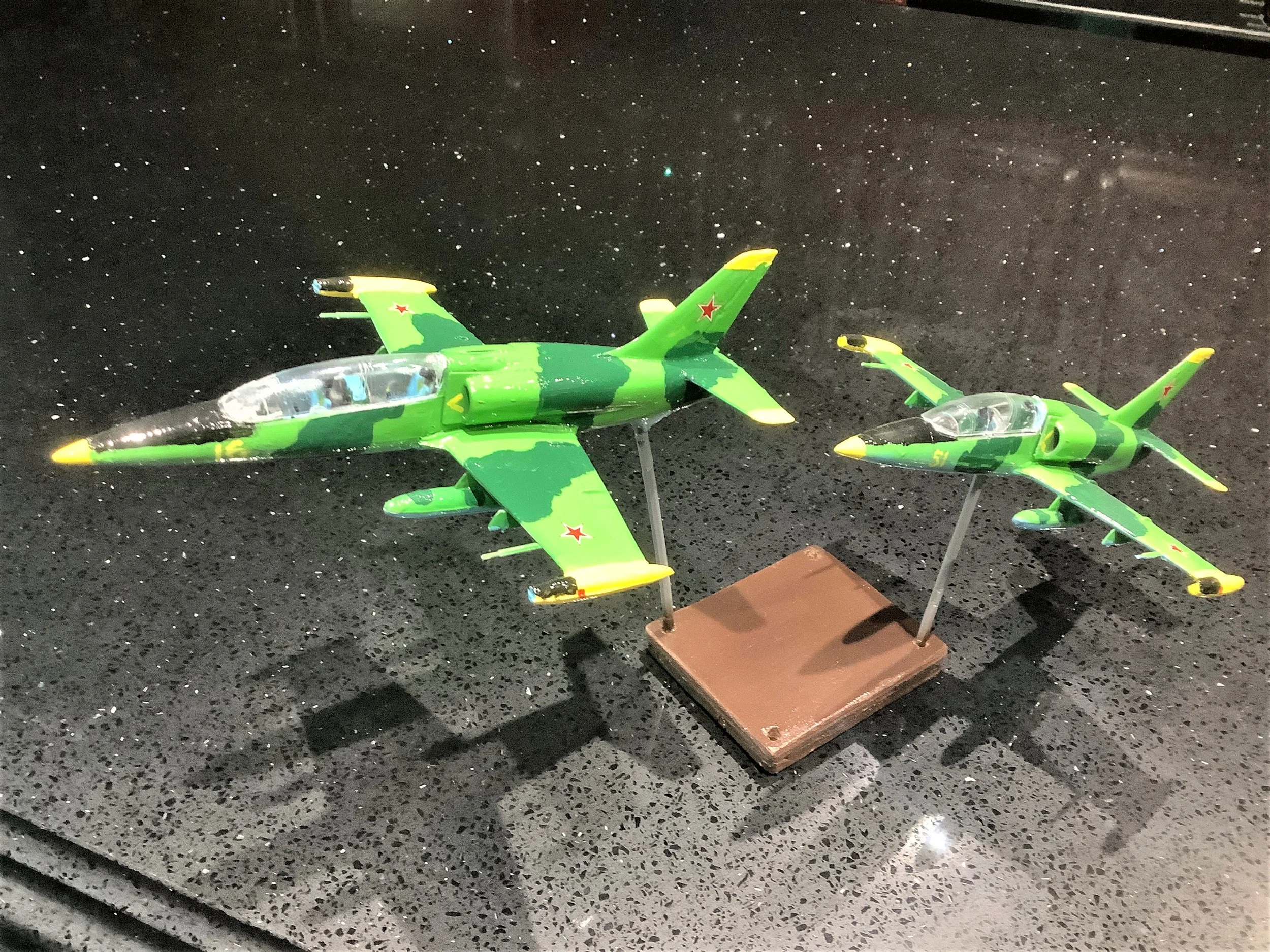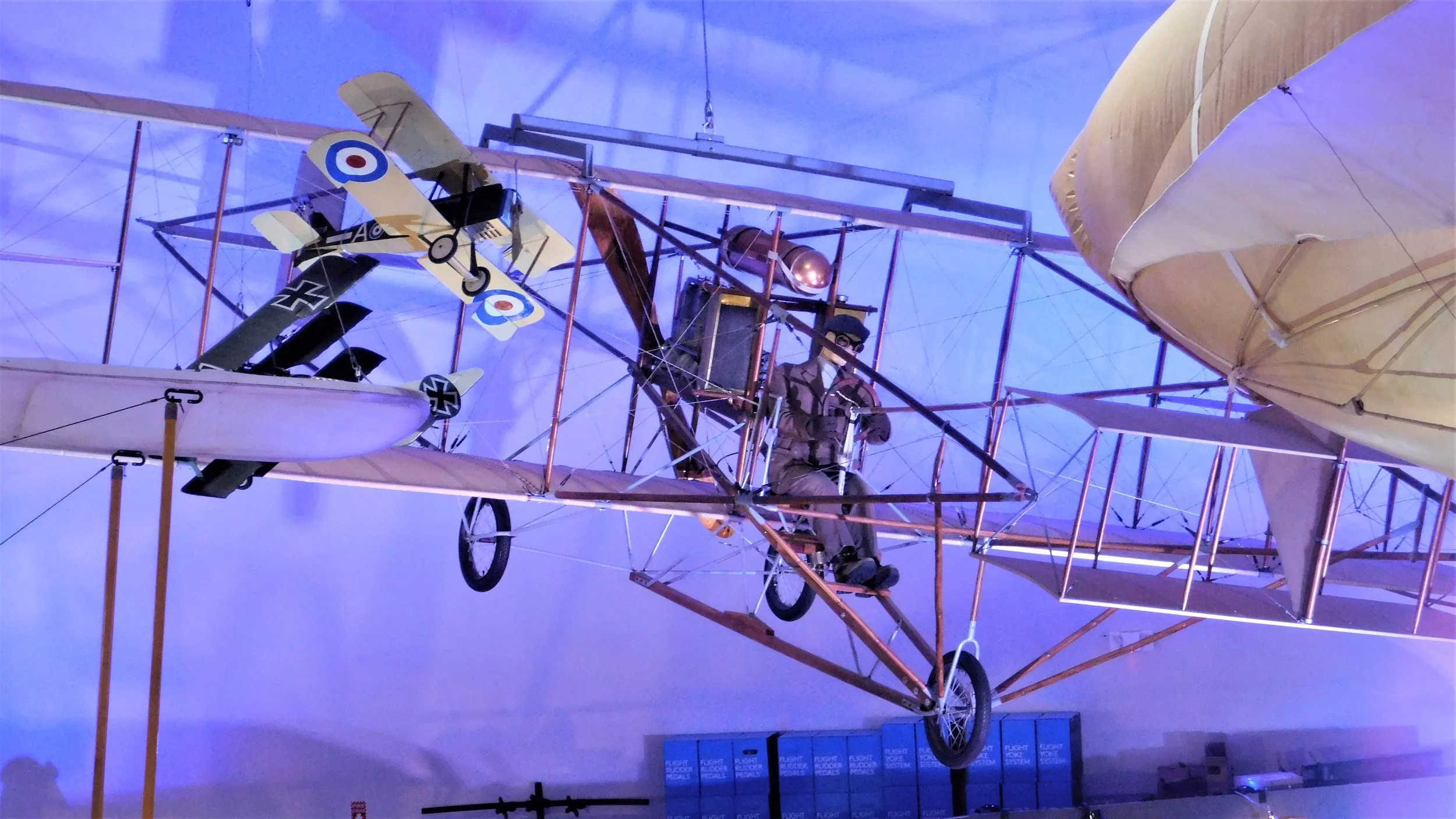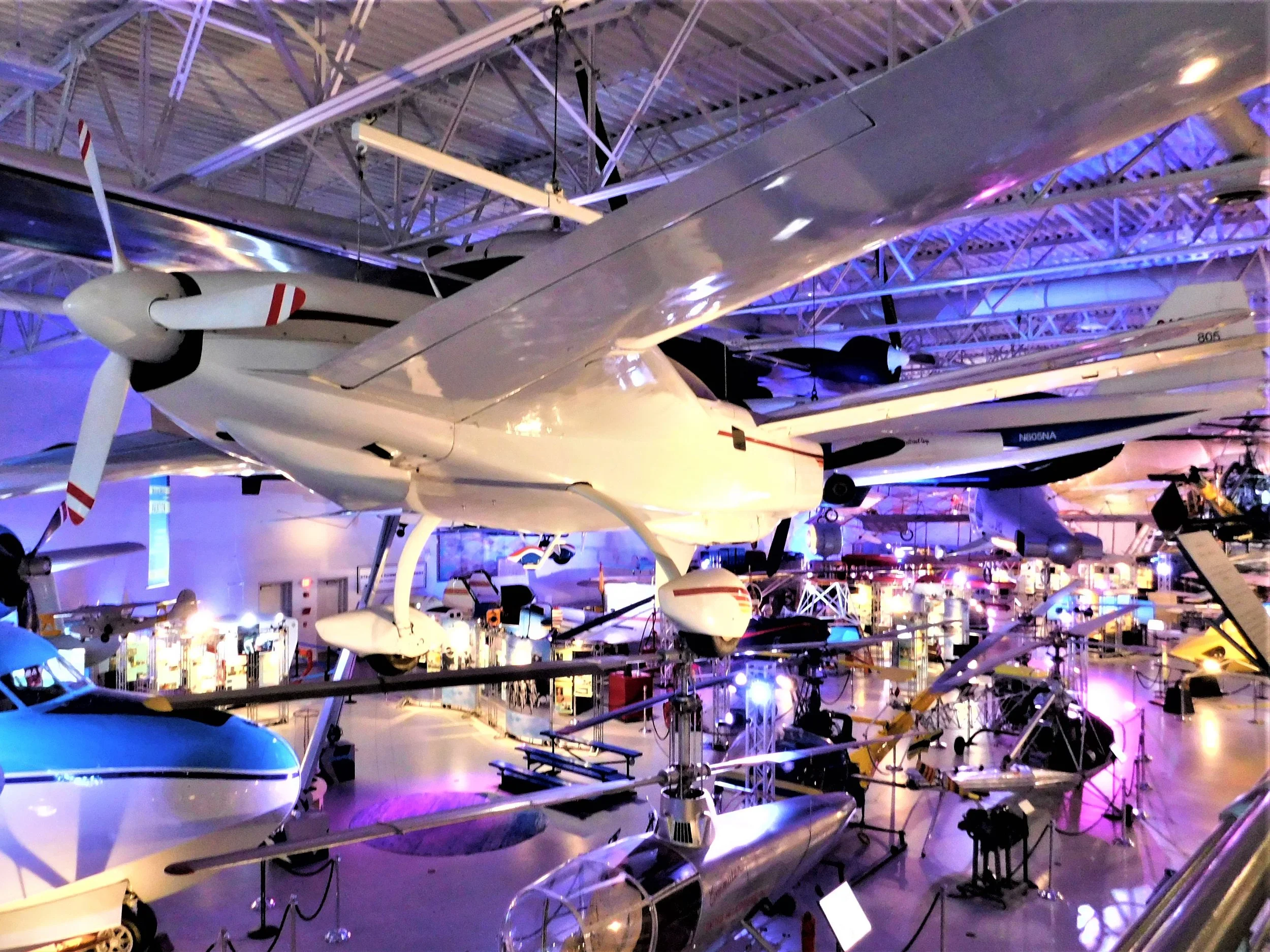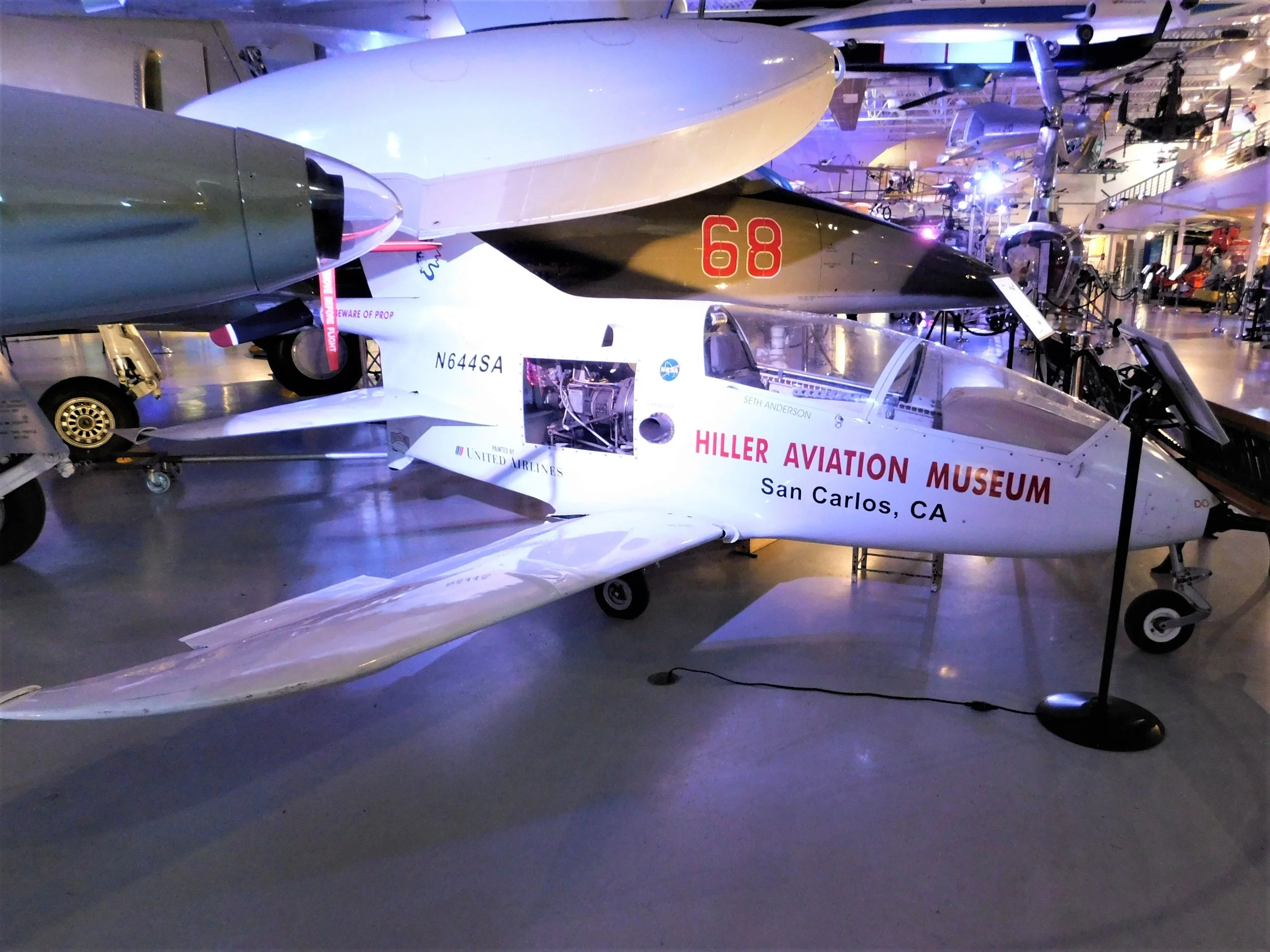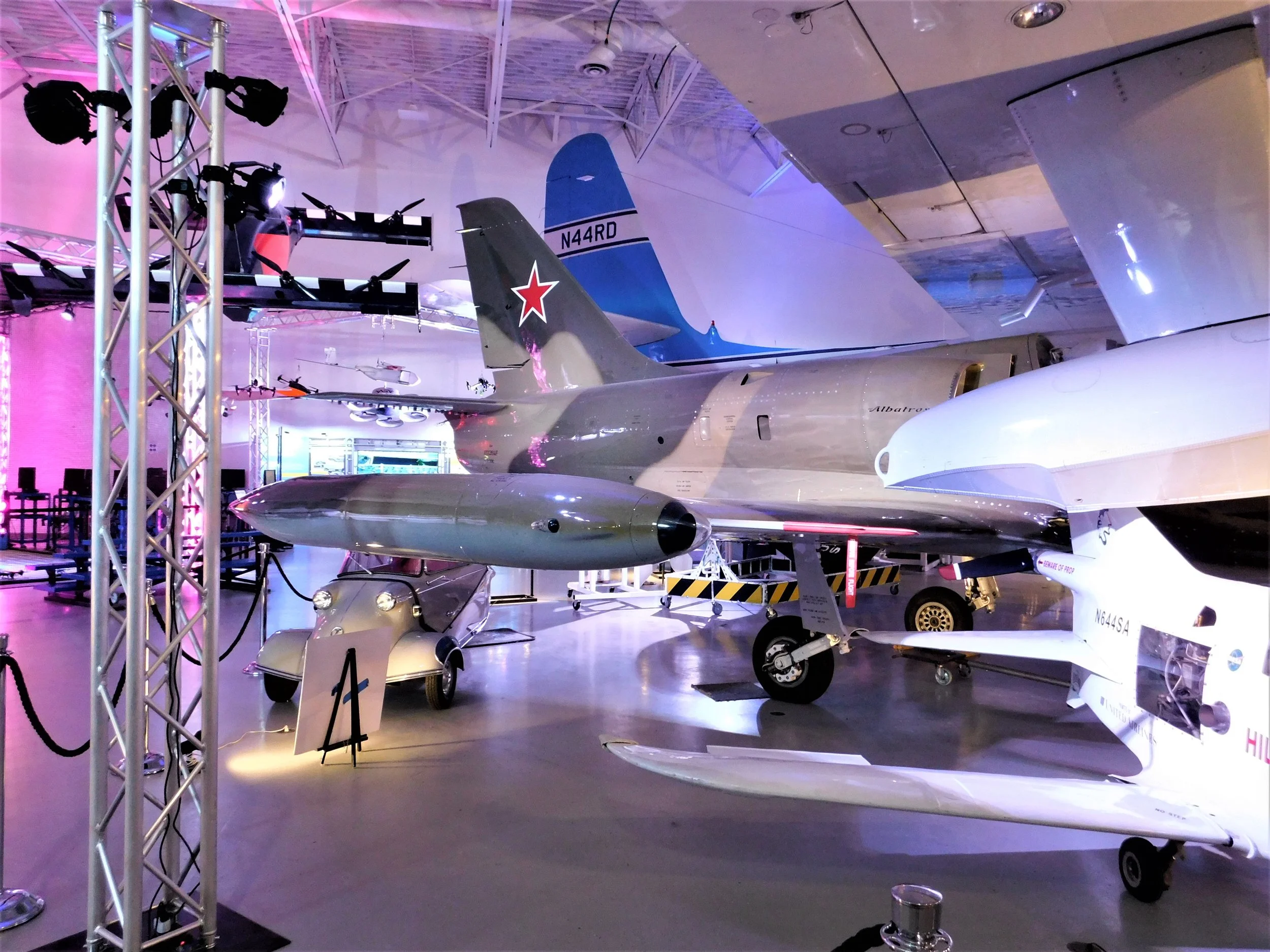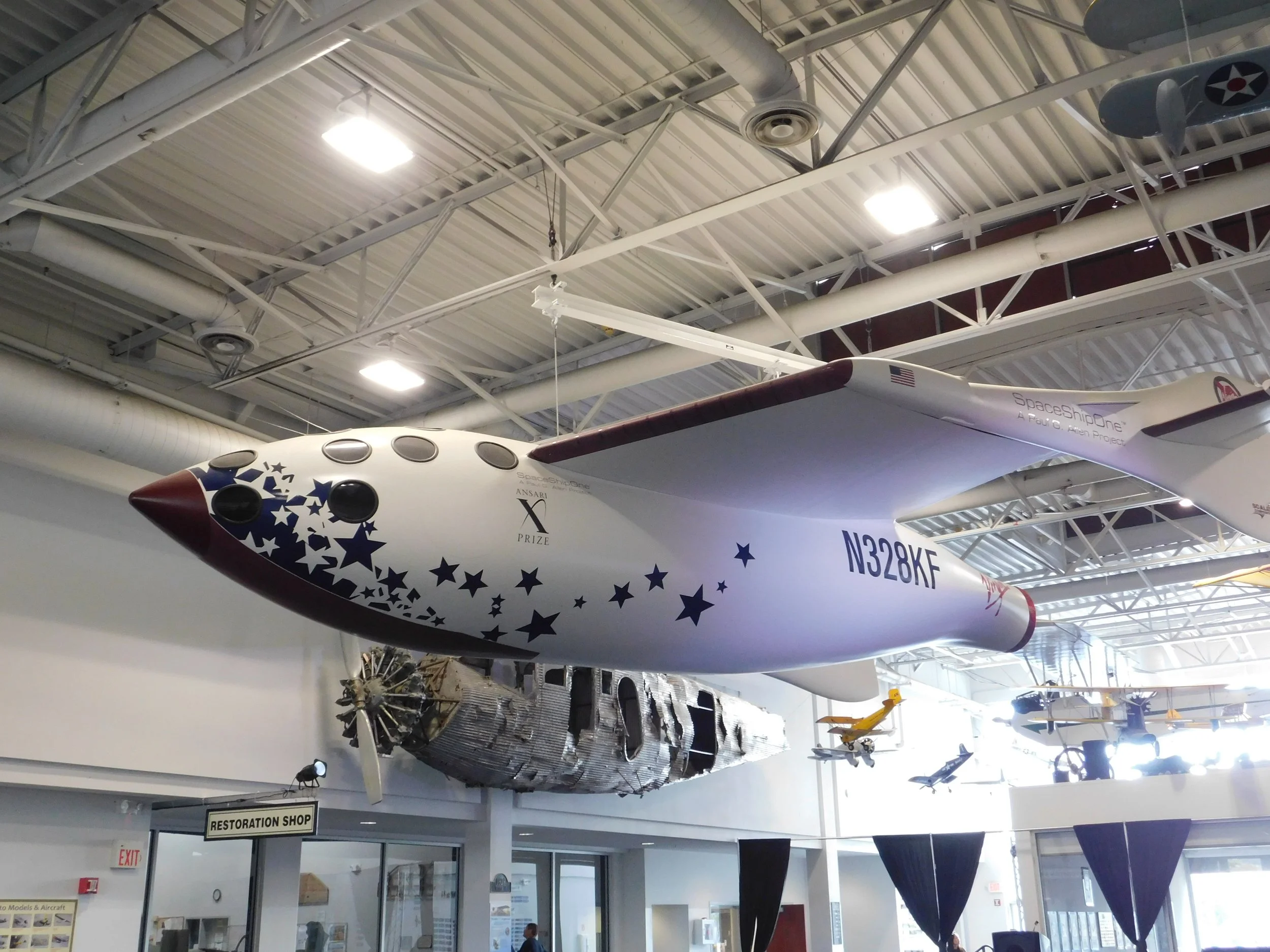Hiller Aviation Museum
Issue 38 A visit to the Hiller Aviation Museum in San Carlos, CA
On June 4 1971, United Airlines Flight 796 left Atlanta bound for Newark. The 737 had scheduled stops in Bristol VA and Charleston WV. At the stop in West Virginia, a retired coal miner boarded the flight. Once airborne, he pushed his way into the cockpit and put a gun to the copilot’s head, demanding to fly to Tel Aviv. The flight diverted to Dulles Airport, to switch to a DC-8 that could fly to Israel. The event ended several hours later, on the ramp at Dulles, when one of the pilots disarmed the hijacker. The nose, with complete cockpit interior, of that 737-200 (N9065U), is on display at the Hiller Aviation Museum in San Carlos, CA.
————————————————————
The Hiller Aviation Museum was founded by helicopter pioneer Stanley Hiller. Over the years, Hiller had collected a wide variety of aircraft which were stored in a warehouse in Redwood City. Some of the aircraft in the collection were products of the Hiller Aircraft Company and many were significant and unique. Most had a connection to Northern California aviation. Hiller had a vision to turn the collection into a museum and his goal was achieved when the museum, on San Carlos Airport, was opened to the public in 1998.
The museum is by no means a helicopter museum, but it does have a wide variety of helicopters on display. This is a Hiller 360. In 1948 it was the first of Hiller’s designs to receive a Civil Aeronautics Authority (CAA) production certificate. In 1949, Stanley Hiller made the first trans-continental helicopter flight, from California to New York, in a Hiller 360.
Hiller began designing helicopters at age 15 (when he was a student at Berkley). By age 17 he had one of his designs, the XH-44, accepted by the Army. In 1944, he successfully flew the XH-44 and, in cooperation with Henry Kaiser, founded Hiller Industries (briefly named United Helicopters). After WW 2, the company name was changed to Hiller Helicopters. For the next 20 years, the Hiller plant in Palo Alto produced a number of experimental designs.
One of those designs, produced in the early 50s, was the YH-32 Hornet, an ultralight jet powered helicopter. The YH-32 was powered by two ram jets on the ends of the rotors. There were many advantages to the design of the YH-32 and a number of applications were envisioned. Eighteen examples of the Hornet were built and, in many ways, it was considered a success (for the early 1950s), but it did not go into production.
A second YH-32 on display is this modified version that was tested as a weapons platform. Named the Sally Rand, this highly classified Army version was probably the first helicopter gunship.
Hiller Helicopters developed a number of other experimental concepts, including building surveillance satellites for the CIA. The company was purchased by Fairchild Aircraft in 1964. After selling the company, Stanley Hiller went on to a career as a corporate turn-around specialists for a number of companies including Bekins, Baker Hughes, and Borg-Warner. During this time, he also served on the Board of Directors of Boeing.
Although Museum is not laid out in any particular order or design, there is one section I found to be more organized here than in other museums and I was particularly impressed by the layout.
Most aviation museums present a lot of information on displays and panels and those panels differ greatly in their design, attractiveness, readability, and effectiveness. Hiller has adopted an open wall format to present these panels, making them particularly effective. The skeleton “walls” allow the presentation of a lot of material, while maintaining the openness of the museum. A wide variety of subjects are displayed in this manner- Aviation careers, Women in Aviation, Forces of Flight (basic aerodynamics), Weather, The First Transcontinental Flight (Vin Fiz), and Beginnings of Flight (early aviation in California). Each of these sections presents a wealth of information- attractively presented and liberally illustrated. The design walks the visitor through the section, so the material can be logically viewed. The structures for the displays are metal scaffolding that were designed and custom built by museum president and curator, Jeffery Bass.
The gallery of Women in Aviation is quite extensive, and depicts a number of women aviators. Many are well-known, and some aren’t as well known.
Louise Thaden, who was born Louise McPhetridge in Arkansas in 1905, was an aviator I had heard of, but I didn’t know much about. In 1926 she was working in sales for a coal company in Wichita. One of her customers was the Travel Air Company, co-founded by Walter Beech. Beech got to know McPheteridge and he offered her a sales position in San Francisco. A perk of the position was free flying lessons and, in 1928, she became the fourth female pilot to be licensed in the U.S. Around that time, McPhetridge met and married Hubert von Thaden, a pilot and aircraft designer. Together they operated the Thaden Metal Aircraft Company (we will see one of their aircraft- the Argonaut, later on). By 1929, just one year after earning her license, Thaden was nationally recognized as a top female pilot. She held women’s speed, altitude, and endurance records. In 1929, Louise won the first Women’s Air Derby Race (known as the Powder Puff Derby) from Santa Monica to Cleveland. Along with Amelia Earhart and several other women pilots, she co-founded an international organization for women, the Ninety-Nines. In 1936, Thayer won the Bendix Trophy Race, flying from New York to LA in a Beech Staggerwing. This was the first year women were allowed to compete and another woman, Laura Ingalls, finished second.
This is the actual 1928 Travel Air D-4-D that Louise Thaden flew and in which, in 1929, she set a women’s endurance record of over 22 hours aloft. This same plane was later flown by another female pilot, Suzanne Asbury-Oliver. In the 1930s, skywriting was a major form of advertising and Suzanne was one of the very few female pilots in the profession, skywriting in the Travel Air under the sponsorship of Pepsi.
Dominating the center of the museum is this Grumman HU-16 Albatross. First flown in 1947, the Albatross was used by the Air Force, Navy, and Coast Guard, primarily for search and rescue operations. The Air Force used the HU-16 extensively during the Korean War. Many of these rugged amphibians were purchased as military surplus and used for a variety of civilian purposes. They were flown as airliners by Pan American and Continental in the Pacific in the 1960s, and by Chalk’s in Florida in the 1980s.
In 1977, Reid Dennis and Andy Macfie flew this particular Albatross around the world (the first HU-16 to do so). The mission was to support the filming of a re-creation of Amelia Earhart’s final flight. After the flight, Reid Dennis donated the plane to the Hiller Museum.
The pilot I was flying with on this trip, German Kleiman, accompanied me on my visit to the museum. When I was walking up to this Aero L-39 Albatros, German was standing next to it. He told me that he flew this type of plane in flight training, and it was the first jet he had flown. German is from Ukraine and I asked him to tell us a little about flying the L-39-
“The L-39 jet was designed in Czekoslovakia (now Czech Republic) by Aero Vodochody.Almost all pilot military schools used her as an initial and advance trainer jet. It was used in the Soviet Union and other socialist countries in the 1980s.I flew the L-39 from 1987 to 1991 during my Air Force pilot training. The general purpose of this jet was to teach pilots military operations (to use bombs, rockets, intercept air targets, aerobatics and formation flights) before moving up to bigger and heavier MIG and Sukhoi jets.The experience that I got on this airplane was unforgettable. The ability to fly L-39 day or night, VFR or IFR, single or formation flights, in a pressurized cockpit made this airplane a unique trainer jet. These scale models are always on my desk.” (German built these models, ed)
Photo courtesy of German Kleiman
German’s journey from aviation cadet in the Soviet military to Gulfstream 650 captain in the U.S. was long, interesting, and more than a little complicated. Thanks, German, for sharing a part of your story!
Throughout the museum there are examples of unique attempts at vertical flight. This is a replica of the 1908 Aerocycloid built by J.C.Ervine, who was the president of the Pacific Aero Club. The four disc-shaped “platens” would rotate and be vertical on the upstroke and horizontal on the downstroke- producing lift. The pilot had two levers- one would move the platens forward and aft and the other would warp the platens to move the craft left or right. The machine was powered by a 7H.P. Indian motorcycle engine and it most likely never flew successfully. The control system, however, clearly predicted the use of collective control that is still used in helicopters today.
A more successful example of vertical flight is this 1955 Hiller Flying Platform Model 1031. With two counter rotating props providing lift, the Flying Platform was the first use of a ducted fan. This concept has since been used in a number of vertical take-off and landing craft (VTOL), including the Lockheed Martin F-35. This Flying Platform was the prototype and the first of six different versions that were built. It is one of only two remaining original craft.
Public domain photo
By 1948, Hiller Helicopters was well established in California. As mentioned earlier, the company produced many innovative designs. This J-10 is a good example of Hiller’s innovation. This prototype, built in 1947, was the first NOTAR (No Tail Rotor) helicopter built. The concept, which has been used on a number of helicopters since, uses the Coanda effect- air leaving the two fan outlets at the rear tends to flow along the surface of the helicopter, providing lateral stability.
I have always appreciated all-aluminum aircraft especially those like the J-10, with an art deco look.
Another Hiller design with a similar look is the UH-4, which was produced in 1946. The concept of this two-seater was as a personal transportation craft. It was aimed at the returning GIs, following WW 2. In 1946 and 1947 there was indeed an explosion in growth for private flying and light aircraft manufacturers flourished. The huge growth in private flying ended as fast as it began, and a market for the UH-4 never materialized.
Another aluminum aircraft on display is this 1928 Thaden T-1 Argonaut. This corrugated aluminum plane was built by the Thaden Metal Aircraft Company of San Francisco and was one of the first aircraft built in the U.S. having a self-supporting metal skin. It was also the first all-metal aircraft built in the Western United States. Designed and built by Herbert von Thaden, this was the only example of this 8-seat transport built and it crashed in Alaska in 1933. In 1986, the Argonaut was recovered from the Alaskan river bed by Herbert Thaden’s son William. It is displayed in the condition it was in when it was recovered.
Behind the museum is a large ramp that provides an area for activities for kids and a viewing area to watch planes, as well as a couple of aircraft on display.
Throughout the museum there are displays and activities aimed at younger visitors. The museum has a number of open cockpit days during the year and there are many interactive exhibits and flight simulators.
One cockpit that is open any time the museum is open is this nose section of a Flying Tigers Boeing 747.
This 747-136, serial #20269, has an interesting history. It first flew in 1971 and was delivered to British Airways. She flew for British Airways for 27 years and during that time accumulated 106,622 hours, which averages out to over 12 hours a day throughout her life. Her last passenger flight was from JFK to Heathrow in 1998. She was then sold for salvage and flown to Roswell New Mexico, where the venerable 747 made the final one of her 21,639 landings. The salvage company, AAR Corporation, donated the plane to the Hiller Museum, with the provision that the museum would collect it in New Mexico. It was a major undertaking to cut and disassemble the forward 45 feet of the huge Boeing and then transport it through three states to San Carlos. Once at the museum, it took two years and 15,000 hours of work to prepare the exhibit. Much of the assembly work and expertise was donated by United Airlines. The major benefactor of the project was retired Flying Tiger Captain Al Silver, hence its paint job. As I’ve pointed out in previous blogs, a large amount of effort and expense goes into building and maintaining an aviation museum, and this is just one example of the effort people go through to give us a great museum like Hiller Aviation Museum.
The front end of the 747 is preserved as it was on its final flight in 1998. Visitors can get a close- up look of this classic plane that first flew over 50 years ago.
The cockpit provides a good look at what an advanced aircraft looked like before the advent of the “glass cockpit”. This cockpit was obviously designed for three crew members. The many 747s still flying today are mostly 2-man cockpits and all of the systems you see here on the flight engineer’s panel are simplified, automated, and moved to the overhead panel.
As you enter on the lower level of the 747, there are several interesting display cabinets dedicated to the history of the Flying Tiger Line.
The Hiller Aviation Museum has a large number of displays hanging from the ceiling, so be sure to take a good look above when you visit. They are all well described on placards but it can be a challenge to match up the placard with the overhead item it describes; there is just so much to see. On one side of the main display hall there is a balcony, mainly used for youth activities, but it is a good vantage point to view overhead displays
One of the aircraft hanging above is this original plane from 1910, the Black Diamond. It was built by Lan Maupin, a dredge captain together with a shipyard owner, Bernard Lanteri. They built the plane at the shipyard in Pittsburg CA, home of the Black Diamond coal mining company. It was just seven years after the Wright brothers flight and it is possible that Maupin and Lanteri had never even heard of the Wright brothers. Like so many people caught up in the excitement of aviation, these two men decided to take action and build their own flying machine. It is possible that the men had seen a Glenn Curtiss plane on display, but they likely produced their design mainly from photographs and drawings in magazines. Their creation successfully flew (with Weldon Cooke as pilot) for several years. At the 1912 Los Angeles Air Meet, the plane won the award for most time in the air during the five-day meet (over 23 hours), as well as the highest altitude (5,600’). After the meet, the plane was considered to have reached the end of its lifespan and was crated up and sent to Lanteri’s shipyard. The Black Diamond sat in the crates for many years. In the 1930s, it was briefly on display in the Oakland airport. The story of how it got from there to be restored by the craftsmen at Hiller is quite interesting. It involves the Smithsonian Museum as well as the Experimental Aircraft Association’s (EAA) Paul Poberezny, and the story on the museum’s website is well worth reading-
Like most museums, Hiller has many model aircraft on display (over 500). Some of the models are in well-marked cabinets, and many others are hanging above.
In most museums there is so much to see that the models tend to get lost in the shuffle. Hiller uses a simple and rather unique method to let visitors know about their model aircraft - a four panel brochure. The name and general location of each plane helps visitors find and identify these excellent models.
Another suspended aircraft is this Rutan Model 74 Defiant, which first flew in 1978. Burt Rutan is well-known for his futuristic and successful aircraft designs. His resume includes being lead designer on the Model 76 Voyager. In 1986, the Voyager, flown by Burt’s brother Dick and Jeana Yeager, became the first plane to fly non-stop around the world without refueling.
The canard (smaller airfoil in front), push-pull (one engine in front, one in back) Model 74, was constructed with fiberglass over Styrofoam. The Defiant was fast and efficient but due to financial challenges and a changing market, the plane never went into production. The design and construction methods, however, foresaw future aircraft, including Rutan’s successful kit aircraft, the VariEze and the Long-EZ. After dropping plans to manufacture the Defiant, Rutan did produce plans for a kit aircraft, but only a few were built and flown. The Model 74 on display here was the prototype and Burt Rutan flew it as his personal plane for many years, eventually donating it to the Hiller Museum.
A nice feature of this museum is that a restoration area is visible to visitors. Even if there is no restoration going on, it is interesting to see what is in process. In the shop is a ¾ scale composite P-51 Mustang and Hiller UH-12.
Let’s return to the United Airlines hijacking from the opening story, but first a note about the crew of this 737-200. The 737 was obviously built as a two-man cockpit; there is no flight engineer panel. When United took delivery of the first 737, in 1968, the Air Line Pilots Association (ALPA) negotiated to have a 3-man crew, including a second officer, or “flight engineer”. The fight for this staffing went on for a long time (when I was hired by United, in 1979, my first position was as a 737 “flight engineer”. There was no such thing as an FAA 737 flight engineer rating and so new hires had to first go through a rating course on the 727 and then go back and start 737 school). There is not a lot of extra room in a 737 cockpit and the “engineer” would sit on the jump seat. The presence of a second officer played a big role in this hijacking.
The hijacker, who was a loner who lived above a bar, was clearly delusional- thinking that the U.S. was under the threat of imminent nuclear attack, and that West Virginia was the primary target. He wanted to fly to Tel Aviv to be as far away from the blast as possible. A short while after takeoff from Charleston, the flight engineer left the flight deck to use the restroom. When he returned, he announced “we have a hijacker”. The captain turned to see a gun being pointed at the engineer’s head. The man with the gun pushed the engineer back into the cabin and closed the cockpit door. The crew told the hijacker that they would need a DC-8 to fly to Israel and he agreed that they would divert to Dulles airport. Once there, the hijacker allowed the passengers and flight attendants to deplane down the airstairs. After everyone was off the plane, the door was closed and the hijacker stayed in the cabin with the second officer, while the captain and first officer remained in the cockpit with the door closed. After several tense hours, the hijacker became distracted, the second officer grabbed the gun, and the event ended peacefully.
————————————————————————————————————————
The Hiller Aviation Museum is an eclectic collection with emphasis on helicopters and Northern California aviation history. There is also an emphasis on youth entertainment and education. As usual, there are many more exhibits in this museum that I could write about- take a look at the gallery below to see more planes on display. Hiller is a great place to visit!
Special thanks to Willie Turner and Jenna Kimberlin, of the Hiller Museum, who assisted with my research.
—————————————————————————————————————
To learn about what to do in the local area, museum hours and costs as well as books to read and other interesting odds and ends, keep reading! At the end you will find a photo gallery of the entire museum.
PLANNING YOUR VISIT
Hours of Operation
Open 10 am – 5 pm, 7 days a week
Admission Fees
$19.00 Adult
$12.00 Seniors (Age 65+)
$12.00 Youths (5-17)
Children (4 and under) free
Museum Members free
FLYING IN
The museum is located on San Carlos Airport (KSQL). The public airport has a 2600’ paved runway (12/30) with RNAV approaches to 30. The airport operates a full service FBO. You can park on the ramp right behind the museum.
LOCAL ATTRACTIONS
San Carlos is located several miles south of San Francisco Airport and 25 miles south of the city of San Francisco.
WHERE TO EAT
The aviation themed Sky Kitchen is located on the airport and was highly recommended by the museum staff. It is open for breakfast and lunch. Collections Manager, Jenna Kimberlin, added this- “downtown San Carlos has LOTS of restaurants, bistros, and wine bars along Laurel Street that range from hipster to traditional. It’s nice to just wander around and park yourself at an outdoor table. I personally love the cupcakes at Susie Cakes which is an adorable vintage style bakery.” Thanks Jenna!
SUGGESTED READING
After writing the segment about Pan American Airlines for last month’s blog (Cradle of Aviation Museum), I pulled Pan Am, by Barnaby Conrad III, off my bookshelf and re-read it. This beautifully illustrated book covers the full history of this historic Airline. Published in 1999, the coffee-table book is available (often at a pretty good price) on all the usual sites. The book covers the entire history of the airline, but the era from Pan Am’s founding (1927) to WW 2, part of the Golden Age of aviation, is especially well covered in both photos and descriptions. A great read about the era, as well as about Pan Am.
MUSEUM WEBSITE
UP NEXT
College Park Aviation Museum, MD
MUSEUMS ARE WHERE YOU FIND THEM
This segment is dedicated to finding interesting aviation artifacts that are in public view- but not in an aviation museum. If you see one send a photo!
Many military installations have aircraft on display. This Bell UH-1 Huey sits proudly in front of the Army National Guard facility on Bradley International Airport.
On the other side of the airport, at the Bradley Air National Guard Base, you can see an A-10, an F-102, and an F-100 on display. The three Air Force planes are not as easy to see as the Huey (or to photograph), because they sit beyond a chain link fence. They are still worth seeking out to get a look.
PHOTO GALLERY
Click any photo to enlarge
Issue 38, Copyright©2022, Pilot House Publishing, LLC. All rights reserved.
Except where noted, all photos by the author.



